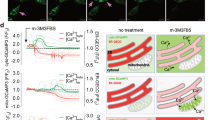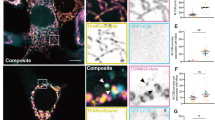Abstract
Whilst the role of ceramide, a second messenger of the sphingolipid family, in the initiation of receptor-mediated apoptosis is controversial, a growing body of evidence is emerging for a role of ceramide in the amplification of apoptosis via mitochondrial perturbations that culminate in the activation of execution caspases. Treatment of Jurkat T cells with the cell-permeable analog, C2-ceramide, resulted in the rapid onset of apoptosis as evidenced by Annexin V-FITC staining of externalised phosphatidylserine residues. Cells bearing this early apoptotic marker had a reduced mitochondrial transmembrane potential (ΔΨm) that was preceded by the release of cytochrome c from mitochondria. Subsequent activation of caspase-3 provides the link between these ceramide-induced mitochondrial changes and execution caspases that ultimately result in the physical destruction of the cell. Collectively these results demonstrate that ceramide signalling results in caspase-mediated apoptosis via mitochondrial cytochrome c release and are further supportive of the role of ceramide in the amplification of apoptosis.
Similar content being viewed by others
References
Kolesnick RN, Haimovitz-Friedman A, Fuks Z. The sphingomyelin signal transduction pathway mediates apoptosis for tumor necrosis factor, Fas, and ionizing radiation. Biochem Cell Biol 1994; 72: 471–474.
Cifone MG, De Maria R, Roncaioli P, et al Apoptotic signaling through CD95 (Fas/Apo-1) activates an acidic sphingomyelinase. J Exp Med 1994; 180: 1547–1552.
Cifone MG, Roncaioli P, De Maria R, et al Multiple pathways originate at the Fas/APO-1 (CD95) receptor: Sequential involvement of phosphatidylcholine-specific phospholipase C and acidic sphingomyelinase in the propagation of the apoptotic signal. EMBO J 1995; 14: 5859–5868.
Tepper CG, Jayadev S, Liu B, et al Role for ceramide as an endogenous mediator of Fas-induced cytotoxicity. Proc Natl Acad Sci USA 1995; 92: 8443–8447.
Gulbins E, Bissonnette R, Mahboubi A, et al FAS-induced apoptosis is mediated via a ceramide-initiated RAS signaling pathway. Immunity 1995; 2: 341–351.
Gamen S, Marzo I, Anel A, Pineiro A, Naval J CPP32 inhibition prevents Fas-induced ceramide generation and apoptosis in human cells. FEBS Letters 1996; 390: 232–237.
Sillence DJ, Allan D Evidence against an early signalling role for ceramide in Fas-mediated apoptosis. Biochem J 1997; 324: 29–32.
Watts JD, Gu M, Patterson SD, Aebersold R, Polverino AJ On the complexities of ceramide changes in cells undergoing apoptosis: Lack of evidence for a second messenger function in apoptotic induction. Cell Death Differ 1999; 6: 105–114.
Watts JD, Gu M, Polverino AJ, Patterson SD, Aebersold R Fas-induced apoptosis of T cells occurs independently of ceramide generation. Proc Natl Acad Sci USA 1997; 94: 7292–7296.
Tepper AD, de Vries E, van Blitterswijk WJ, Borst J Ordering of ceramide formation, caspase activation, and mitochondrial changes during CD95-and DNA damage-induced apoptosis. [erratum appears in J Clin Invest 1999 May; 103(9): 1363]. J Clin Invest 1999; 103: 971–978.
Hsu SC, Wu CC, Luh TY, et al Apoptotic signal of Fas is not mediated by ceramide, Blood 1998; 91: 2658–2663.
Susin SA, Zamzami N, Castedo M, et al The central executioner of apoptosis: Multiple connections between protease activation and mitochondria in Fas/APO-1/CD95-and ceramide-induced apoptosis. J Exp Med 1997; 186: 25–37.
Gamen S, Anel A, Pineiro A, Naval J Caspases are the main executioners of Fas-mediated apoptosis, irrespective of the ceramide signalling pathway. Cell Death Differ 1998; 5: 241–249.
Obeid LM, Linardic CM, Karolak LA, Hannun YA Programmed cell death induced by ceramide. Science 1993; 259: 1769–1771.
Jarvis WD, Kolesnick RN, Fornari FA, et al Induction of apoptotic DNA damage and cell death by activation of the sphingomyelin pathway. Proc Natl Acad Sci USA 1994; 91: 73–77.
Ruvolo PP, Deng X, Ito T, Carr BK, May WS Ceramide induces Bcl2 dephosphorylation via a mechanism involving mitochondrial PP2A. J Biol Chem 1999; 274: 20296–20300.
Garcia-Ruiz C, Colell A, Mari M, Morales A, Fernandez-Checa JC Direct effect of ceramide on the mitochondrial electron transport chain leads to generation of reactive oxygen species. Role of mitochondrial glutathione. J Biol Chem 1997; 272: 11369–11377.
Arora AS, Jones BJ, Patel TC, Bronk SF, Gores GJ Ceramide induces hepatocyte cell death through disruption of mitochondrial function in the rat. Hepatology 1997; 25: 958–963.
Di Paola M, Cocco T, Lorusso M Ceramide interaction with the respiratory chain of heart mitochondria. Biochemistry 2000; 39: 6660–6668.
Ghafourifar P, Klein SD, Schucht O, et al Ceramide induces cytochrome c release from isolated mitochondria. Importance of mitochondrial redox state. J Biol Chem 1999; 274: 6080–6084.
Ito A, Uehara T, Tokumitsu A, Okuma Y, Nomura Y Possible involvement of cytochrome c release and sequential activation of caspases in ceramide-induced apoptosis in SK-N-MC cells. Biochim Biophys Acta 1999; 1452: 263–274.
Cuvillier O, Edsall L, Spiegel S Involvement of sphingosine in mitochondria-dependent Fas-induced apoptosis of type II JurkatTcells. Journal of Biological Chemistry 2000; 275: 15691–15700.
Bossy-Wetzel E, Green DR Caspases induce cytochrome c release from mitochondria by activating cytosolic factors. J Biol Chem 1999; 274: 17484–17490.
Waterhouse NJ, Green DR Mitochondria and apoptosis: HQ or high-security prison? J Clin Immunol 1999; 19: 378–387.
Lee HC, Wei YH Mitochondrial role in life and death of the cell. J Biomed Sci 2000; 7: 2–15.
Scarlett JL, Sheard PW, Hughes G, et al Changes in mitochondrial membrane potential during staurosporine-induced apoptosis in Jurkat cells. FEBS Lett 2000; 475: 267–272.
Amarante-Mendes GP, Naekyung Kim C, Liu L, et al Bcr-Abl exerts its antiapoptotic effect against diverse apoptotic stimuli through blockage of mitochondrial release of cytochrome c and activation of caspase-3. Blood 1998; 91: 1700–1705.
Zhang J, Alter N, Reed JC, et al Bcl-2 interrupts the ceramidemediated pathway of cell death. Proc Natl Acad Sci USA 1996; 93: 5325–5328.
Tepper AD, Ruurs P, Wiedmer T, et al Sphingomyelin hydrolysis to ceramide during the execution phase of apoptosis results from phospholipid scrambling and alters cell-surface morphology. [see comments]. J Cell Biol 2000; 150: 155–164.
Green DR Apoptosis and sphingomyelin hydrolysis. The flip side. J Cell Biol 2000; 150: F5-F7.
Annis MG, Zamzami N, Zhu W, et al Endoplasmic reticulum localized Bcl-2 prevents apoptosis when redistribution of cytochrome c is a late event. Oncogene 2001; 20: 1939–1952.
Pervaiz S, Seyed MA, Hirpara JL, Clement MV, Loh KW Purified photoproducts of merocyanine 540 trigger cytochrome c release and caspase 8-dependent apoptosis in human leukemia and melanoma cells. Blood 1999; 93: 4096–4108.
Strasser A, Harris AW, Huang DC, Krammer PH, Cory S Bcl-2 and Fas/APO-1 regulate distinct pathways to lymphocyte apoptosis. EMBO J 1995; 14: 6136–6147.
Sawada M, Nakashima S, Banno Y, et al Ordering of ceramide formation, caspase activation, and Bax/Bcl-2 expression during etoposide-induced apoptosis in C6 glioma cells. Cell Death Differ 2000; 7: 761–772.
Hannun YA, Luberto C Ceramide in the eukaryotic stress response. Trends Cell Biol 2000; 10: 73–80.
Kolesnick RN, Kronke M Regulation of ceramide production and apoptosis. Annu Rev Physiol 1998; 60: 643–665.
Mizushima N, Koike R, Kohsaka H, et al Ceramide induces apoptosis via CPP32 activation. FEBS Lett 1996; 395: 267–271.
Li P, Nijhawan D, Budihardjo I, et al Cytochrome c and dATPdependent formation of Apaf-1/caspase-9 complex initiates an apoptotic protease cascade. Cell 1997; 91: 479–489.
Dbaibo GS, Perry DK, Gamard CJ, et al Cytokine response modifier A (CrmA) inhibits ceramide formation in response to tumor necrosis factor (TNF)-alpha: CrmA and Bcl-2 target distinct components in the apoptotic pathway. J Exp Med 1997; 185: 481–490.
Cuvillier O, Rosenthal DS, Smulson ME, Spiegel S Sphingosine 1-phosphate inhibits activation of caspases that cleave poly(ADP-ribose) polymerase and lamins during Fas-and ceramide-mediated apoptosis in Jurkat T lymphocytes. J Biol Chem 1998; 273: 2910–2916.
Chinnaiyan AM, Tepper CG, Seldin MF, et al FADD/MORT1 is a common mediator of CD95 (Fas/APO-1) and tumor necrosis factor receptor-induced apoptosis. J Biol Chem 1996; 271: 4961–4965.
Karasavvas N, Zakeri Z Relationships of apoptotic signaling mediated by ceramide and TNF-alpha in U937 cells. Cell Death Differ 1999; 6: 115–123.
Grullich C, Sullards MC, Fuks Z, Merrill AH Jr, Kolesnick R CD95(Fas/APO-1) signals ceramide generation independent of the effector stage of apoptosis. J Biol Chem 2000; 275: 8650–8656.
Jaffrezou JP, Levade T, Bettaieb A, et al Daunorubicin-induced apoptosis: Triggering of ceramide generation through sphingomyelin hydrolysis. EMBO J 1996; 15: 2417–2424.
Bose R, Verheij M, Haimovitz-Friedman A, et al Ceramide synthase mediates daunorubicin-induced apoptosis: An alternative mechanism for generating death signals. Cell 1995; 82: 405–414.
Author information
Authors and Affiliations
Rights and permissions
About this article
Cite this article
Hearps, A.C., Burrows, J., Connor, C.E. et al. Mitochondrial cytochrome c release precedes transmembrane depolarisation and caspase-3 activation during ceramide-induced apoptosis of Jurkat T cells. Apoptosis 7, 387–394 (2002). https://doi.org/10.1023/A:1020034906200
Issue Date:
DOI: https://doi.org/10.1023/A:1020034906200




